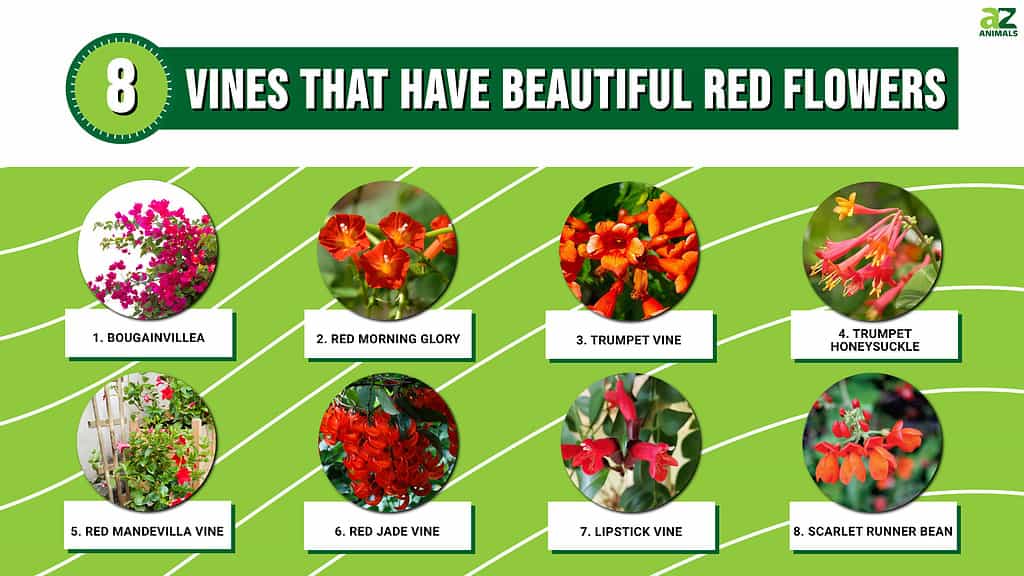
Have you ever gone for a walk in the woods and seen a vine with startling red flowers? Whether it’s a honeysuckle, a trumpet vine, or a morning glory, these flowers are memorable. Maybe you’d like to train a red-flowered vine to grow up a trellis or around an arbor or pergola. Their red color will make quite a statement in your garden or along the outside walls of your house. Here are eight vines with spectacular red flowers.
1. Bougainvillea
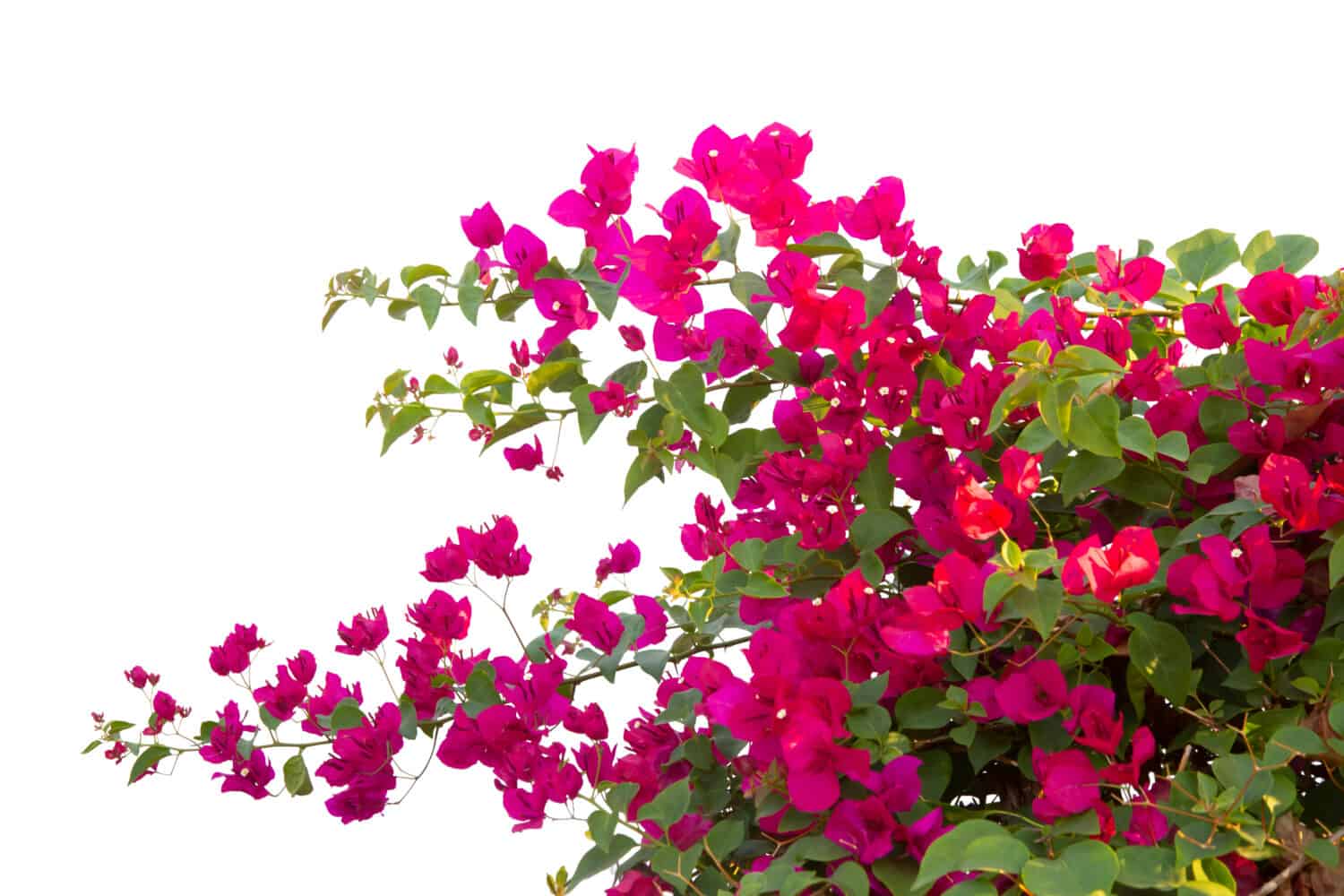
. Bougainvillea is tolerant of drought and salt, so you can plant it near the ocean.
©Kriengsuk Prasroetsung/Shutterstock.com
Though native to South and Central America, this spectacular, red-flowered vine is finding a home in the warmer parts of the United States. Able to withstand light frosts, this vine grows up to 40 feet high with a 1-to-2-foot spread. It clings to arbors, trellises and the side of your house with its thorns. Like the dogwood, the actual flower of the bougainvillea is tiny, and the brilliantly colored “petals” are actually bracts that surround it. They appear in spring and fall. The vine goes dormant in the summer, but it’s an evergreen, so you’ll always have its heart-shaped, bright green leaves. Bougainvillea is tolerant of drought and salt, so you can plant it near the ocean.
Bougainvillea grows best in hardiness zones 9b to 10 and prefers dry soil and full sun. The vine is a heavy feeder, but once it’s established it doesn’t need too much water. Indeed, if it’s overwatered it won’t produce as many flowers.
2. Red Morning Glory
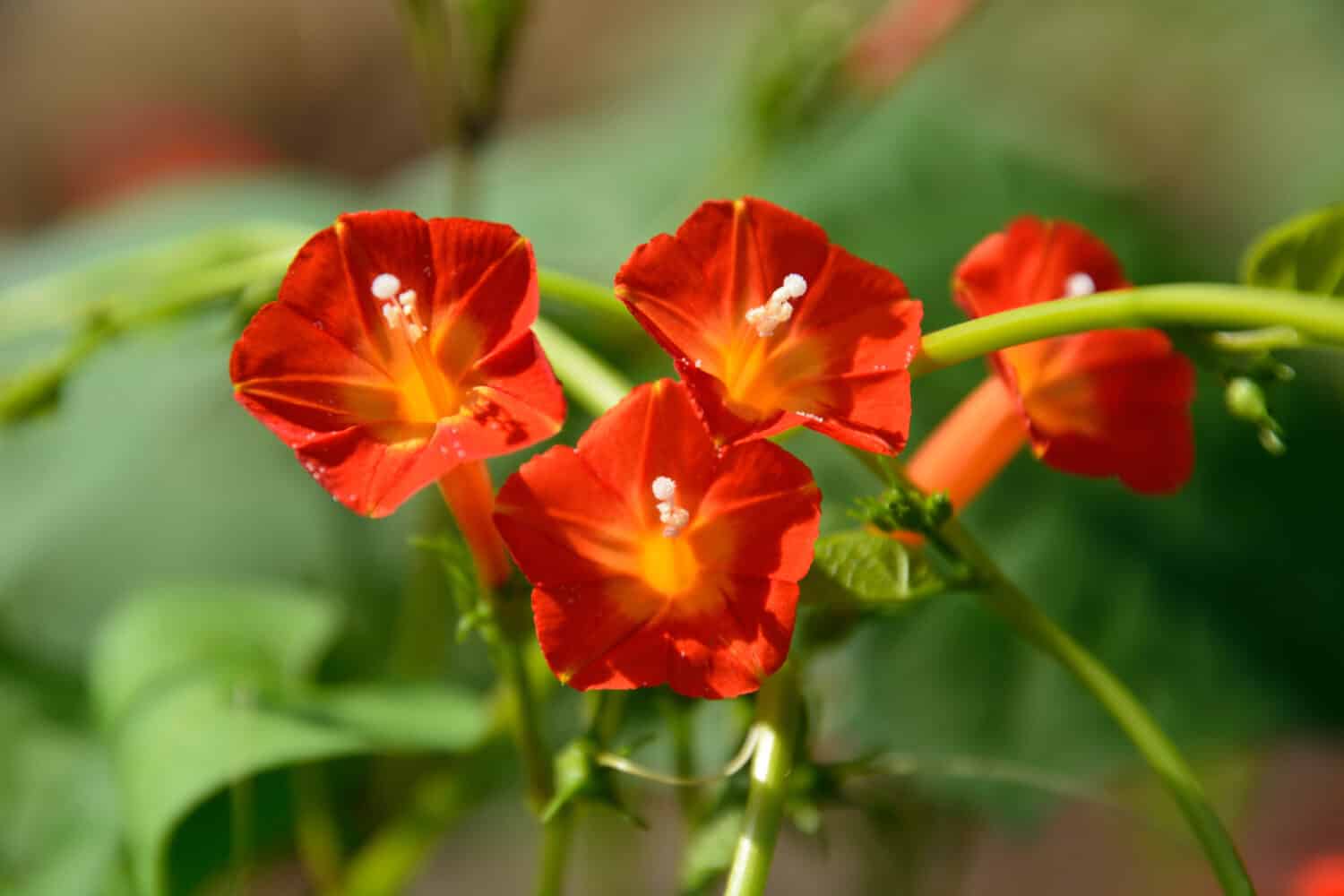
The red morning glory thrives in hardiness zones 9 through 11.
©High Mountain/Shutterstock.com
Native to the tropics of South, Central and North America, this vine is the type that twists around what it grows on. The vine can grow longer than 10 feet and has a spread between 5 and 20 feet. It produces heart-shaped leaves and clusters of red flowers with orange throats whose nectar attracts a variety of pollinators, including hummingbirds and insects.
The red morning glory does best in full sun and in hardiness zones 9 through 11. It’s tolerant of drought and poor soil and is not troubled by serious diseases or pests. The red morning glory is an annual plant, which means it lives for one season, produces its seeds and dies. Its fruit is a capsule that’s about a quarter of an inch long and can contain as many as four seeds. The capsules are brittle, and when they fall, they break and scatter the seeds. Because the seeds germinate readily, the plant can come back year after year and even become invasive, so make sure to keep it under control in your garden.
3. Trumpet Vine
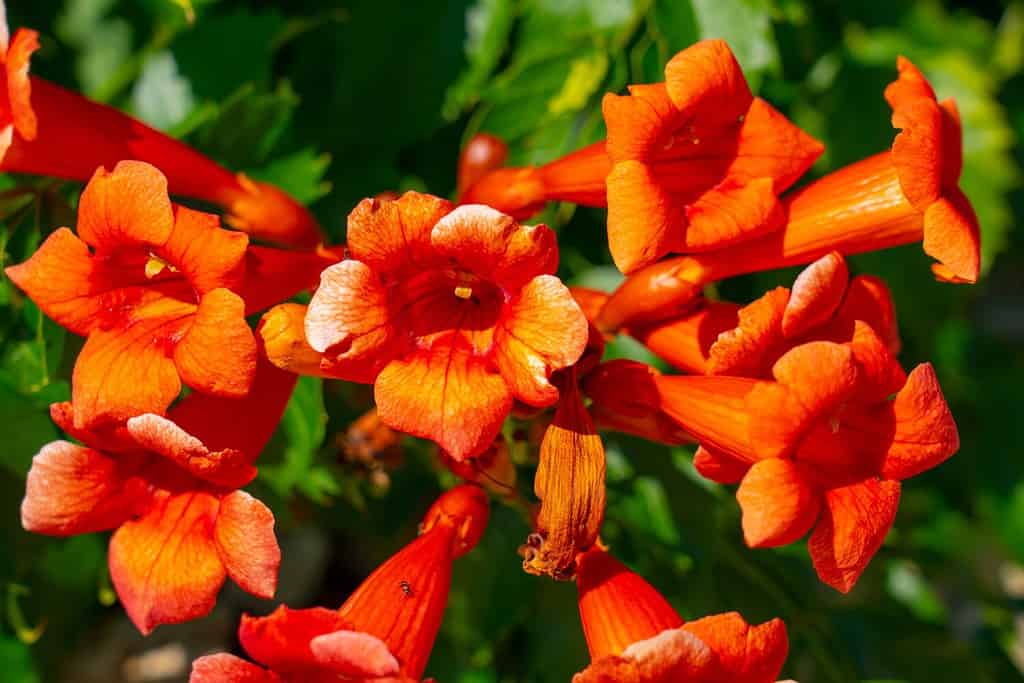
The red flowers of the trumpet vine are irresistible to hummingbirds.
©martin.dlugo/Shutterstock.com
This red-flowered vine is native to the eastern areas of North America. The flower’s bright color and trumpet shape make it irresistible to hummingbirds, and you’ll often see hummingbird feeders utilizing the shape and color of these flowers. It climbs easily and even aggressively up natural objects such as trees and artificial ones such as trellises or buildings. It can climb as high as 33 to 40 feet and branches can reach as much as 7 feet from the main stem. The glossy, dark green, pinnate leaves contrast beautifully with the red of the flower. The flowers appear in the summer and don’t have a scent, though their beauty makes up for this. After the flowers fade, the plant brings forth long seed pods. When they dry up and split, they release hundreds of seeds that the wind carries away.
The trumpet vine flourishes in a wide range of hardiness zones. It does well in hardiness zones 4 to 9 and likes partial shade to full sun. Two things must be discussed when considering the trumpet vine for your garden. It can be invasive and needs to be pruned to keep it tidy, and it causes a rash called cow-itch in some people who touch it.
4. Trumpet Honeysuckle

Wildlife eat the red berries of the trumpet honeysuckle.
©shepherdsatellite/Shutterstock.com
This red flowering vine is native to the eastern part of the United States and is mainly found in the Southeast. It has a twining habit and can grow over 20 feet in length, with clusters of tubular red flowers, waxy, evergreen leaves, and waxy stems that are green on young plants but turn brown then reddish orange in older ones. Only Maine gives the trumpet honeysuckle a conservation status, and it is endangered. Like the trumpet vine, the trumpet honeysuckle attracts hummingbirds and other pollinators. Its red berries are eaten by birds, including robins and quail.
The trumpet honeysuckle does best in hardiness zones 5 to 9. It tolerates cold, resists drought and isn’t particular about soil as long as it drains well. It flourishes in full sun to full shade and in soil that’s a little bit acidic. Deer avoid it, and the plant can even grow around the black walnut, which poisons most other plants.
5. Red Mandevilla Vine
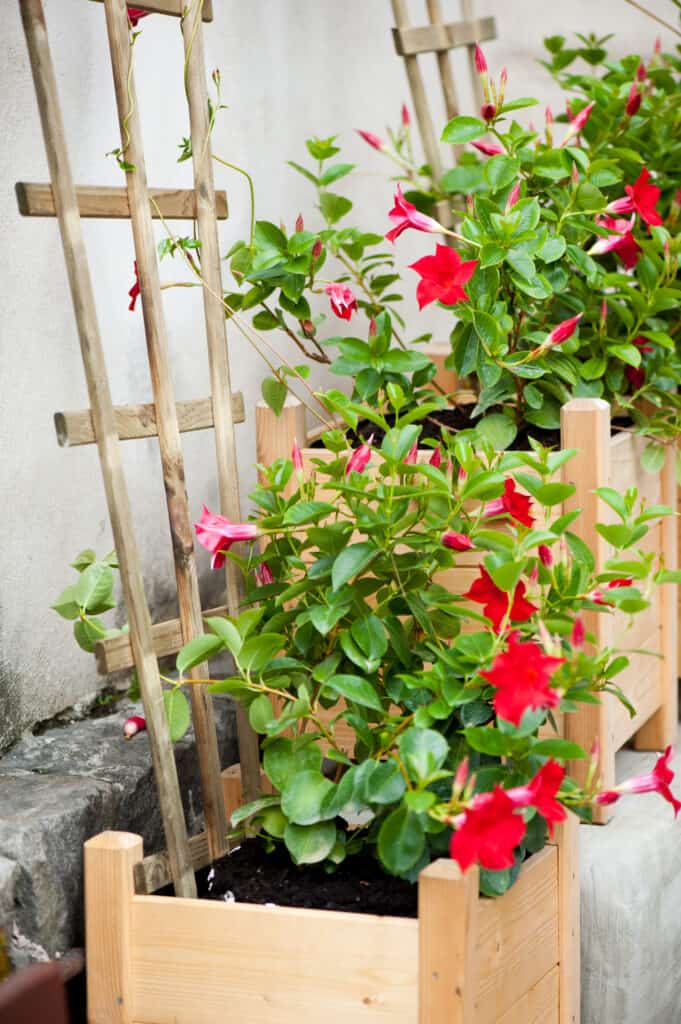
Mandevilla makes a good houseplant.
©Ariene Studio/Shutterstock.com
Also known as Brazilian jasmine and rock trumpet, this fast-growing tropical vine grows between 3 to 10 feet tall and has a 3-to-4-foot spread. It grows best in hardiness zones 10 to 11, where it’s a perennial. It’s an annual in cooler climates and can grow in containers as long as it has support. Indeed, it makes a good houseplant. Water it very sparingly during the winter then prune it back before putting it outdoors when the weather warms.
The large, tubular flower has five petals that form a 3- to 6-inch-wide star. Like many red flowers found on vines, it attracts hummingbirds, butterflies and other pollinators. Flowers arrive in summer, and the leaves are glossy green, wrinkled, pointed and 3 to 8 inches long. The red Mandevilla needs full sun to partial shade and soil that should stay evenly moist but drains well.
6. Red Jade Vine

This vine is also called “flame of the forest.”
©R. Maximiliane/Shutterstock.com
This sensational vine brings forth chains of brilliant red orange blossoms whose shape gives it its other name of flame of the forest. Native to Papua New Guinea, the red jade vine can also be grown in the United States in hardiness zones 10 to 11. The vine can grow as high as 100 feet, and it needs something very sturdy to grow on, such as a trellis attached to your house, a big, healthy tree, or a pergola. It needs heat, and its leaves turn yellow and drop if it gets below 55 degrees Fahrenheit.
Grow this plant in fertile, moist soil that drains well. Make sure that the soil doesn’t get soggy because that can lead to root rot. Unlike a lot of the vines discussed here, the roots of the red jade vine love total shade. If there’s no shady place to put your plant, just cover the roots with mulch to make sure they don’t get too much sunlight. Fertilize with phosphorus in early spring to encourage the blossoms. After the blooms are spent, prune the plant lightly.
7. Lipstick Vine
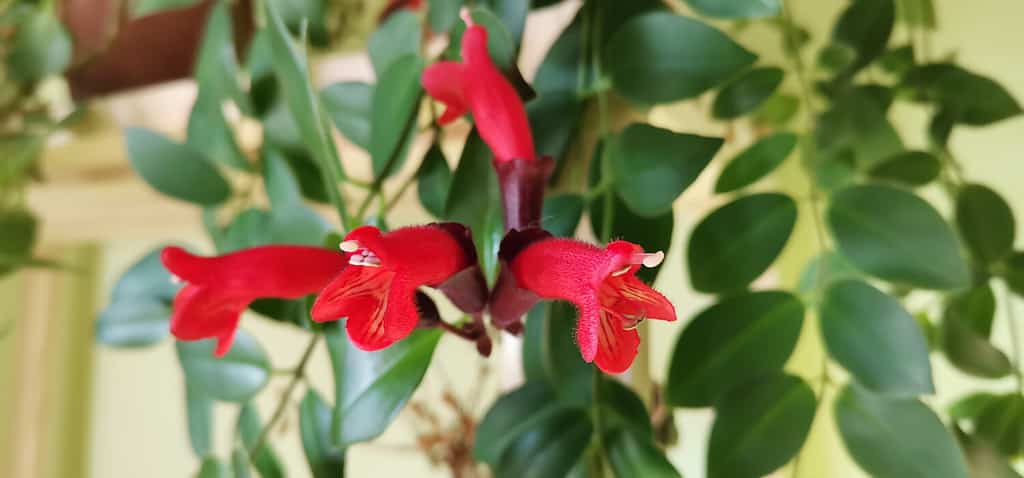
Lipstick vines make good houseplants.
©PeterCam/Shutterstock.com
This plant gets its name because its flowers look like tubes of lipstick. Native to Southeast Asia, it’s a vine that likes to grow on other plants and should be planted outdoors in hardiness zones 10 to 11. In such climates it’s an evergreen and a perennial, and it can grow to 3 feet in length. It needs partial shade and well-draining soil that’s neutral to a bit alkaline. Direct sunlight causes the leaves to scorch, and you need to avoid overwatering it, as overwatering can lead to root rot. The lipstick plant is also popular as a houseplant.
8. Scarlet Runner Bean

The red flowers of the scarlet runner bean resemble pea flowers.
©HelloSSTK/Shutterstock.com
Native to Central and South America, this perennial vine climbs to between 8 and 12 feet with a 3-to-5-foot spread. A member of the pea family, it needs full sun and has a wider range of hardiness zones than some of the other mentioned vines. The scarlet runner bean can flourish in hardiness zones 7 to 11.
The showy flowers appear from June to October, and they are visited by hummingbirds, butterflies and all kinds of bees. One interesting thing about the scarlet runner bean is that it twines clockwise around whatever it’s growing on, while other beans twine the other way.
The vine isn’t just grown for its beautiful flowers but for the beans that follow. Make sure you pick and eat the beans when they’re still young, as they get tough and fibrous when they’re old. The more beans you pick, the more flowers the plant will put out.
Summary of 8 Vines That Have Beautiful Red Flowers
Hummingbirds are sure to love these beautiful red flowers!
| Flower | Hardiness Zone | |
|---|---|---|
| 1 | Bougainvillea | 9b – 10 |
| 2 | Red Morning Glory | 9 – 11 |
| 3 | Trumpet Vine | 4 – 9 |
| 4 | Trumpet Honeysuckle | 5 – 9 |
| 5 | Red Mandevilla Vine | 10 – 11 |
| 6 | Red Jade Vine | 10 – 11 |
| 7 | Lipstick Vine | 10 – 11 |
| 8 | Scarlet Runner Bean | 7 – 11 |
The photo featured at the top of this post is © Martina Sappe/Shutterstock.com
Thank you for reading! Have some feedback for us? Contact the AZ Animals editorial team.







